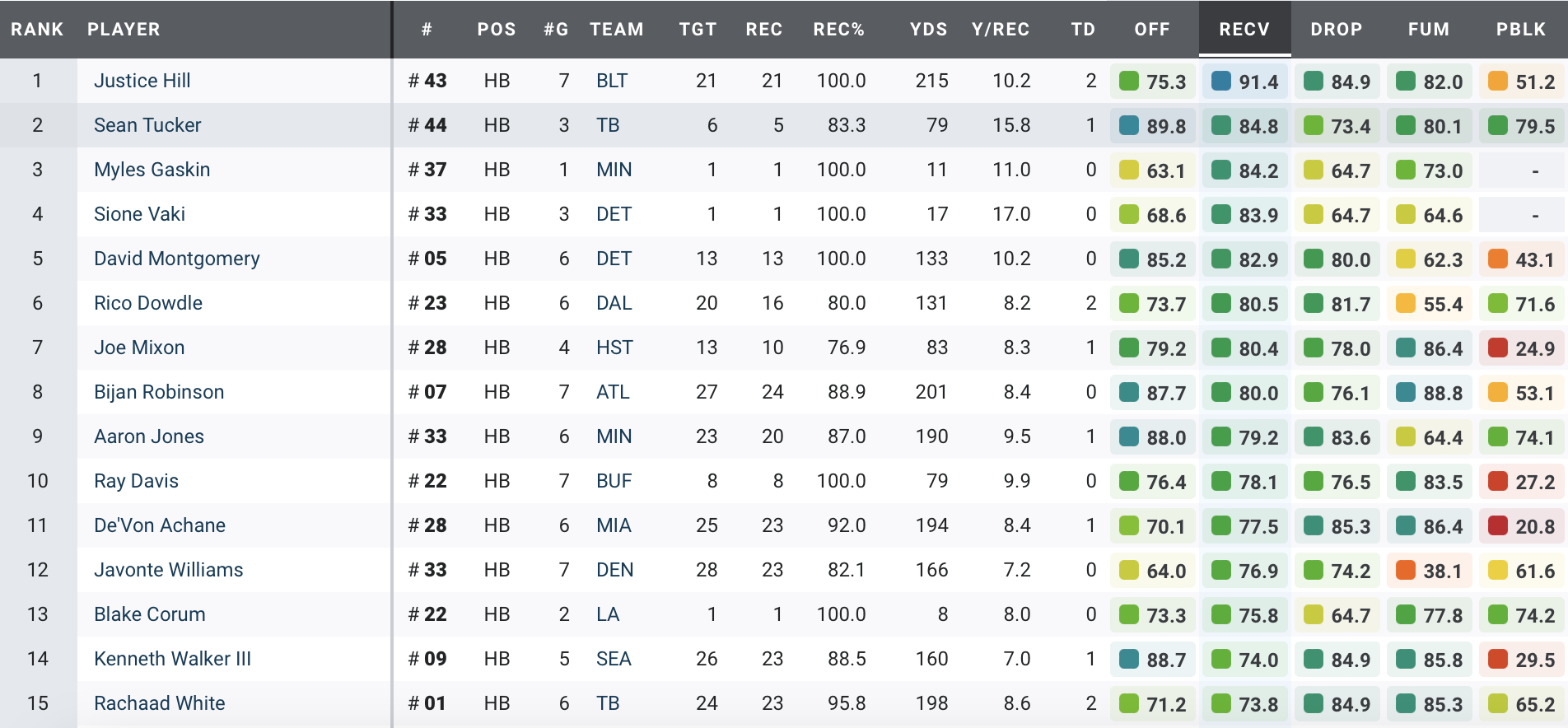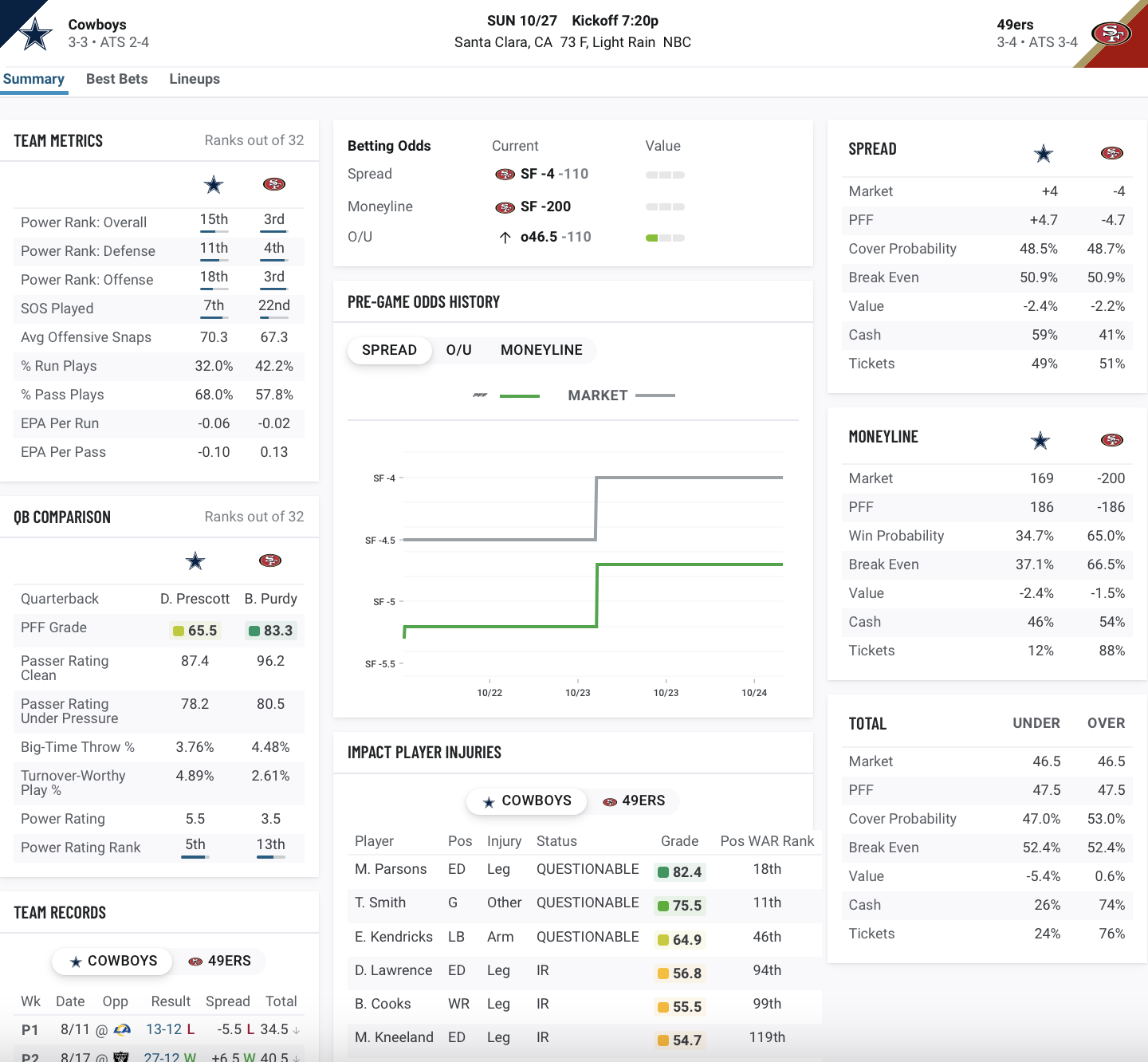• Can the Bengals make Jalen Hurts uncomfortable? Hurts’ 30.8 PFF passing grade under pressure sits 36th out of 39 qualifying quarterbacks, but the Bengals' pass rush has been disappointing all year.
• Will the Cowboys bend or break in the red zone? San Francisco ranks 26th in red-zone EPA per play, but Dallas has allowed 70% of red-zone drives to end in a touchdown.
• Unlock your edge with a PFF+ subscription: Get full access to all our in-season fantasy tools, including weekly rankings, WR/CB matchup charts, weekly projections, the Start-Sit Optimizer and more. Sign up now!
Estimated Reading Time: 7 minutes
While the outcome of every football game is — in some way, shape or form — influenced by the 22 players on each team’s side, what adds an extra layer of nuance is examining the niche, micro-level battles that can define a result. That includes players or units battling head-to-head, or even defensive coaches trying to out-scheme the opposing quarterback.
Whether strength against strength, weakness against weakness or simply an individual war of great consequence, here are eight matchups with a significant probability of determining winners in Week 8.
Jalen Hurts vs. the Bengals’ pass rush
This early-window matchup pits two playoff hopefuls in very similar circumstances against one another: receiving corps that are nearly unstoppable with shaky defenses. The defining factor could very well be quarterback play — and that means the Eagles will need to get a better version of Jalen Hurts.
Hurts has struggled in 2024, ranking 32nd in PFF passing grade among qualified quarterbacks. In particular, he’s been very subpar when under pressure. Hurts’ 30.8 PFF passing grade under pressure sits 36th out of 39 qualifying quarterbacks. The disparity between Hurts’ play under pressure and when kept clean is enormous, as evidenced by his 82.8 PFF passing grade when not dealing with rushers.
Meanwhile, one of the Bengals' fundamental problems this year is the pass rush. Star Trey Hendrickson has heated up over the past two weeks, recording 13 pressures and four sacks, but the unit is still performing below expectations. Cincinnati ranks 17th in total pressures generated and 22nd in pressure percentage.
If Lou Anarumo’s defense can generate sufficient pressure from secondary options like B.J. Hill and Sam Hubbard, then Hurts could be prone to making a mistake. Even then, the Bengals need to key on Hurts’ scrambling — his 83.9 rushing grade under pressure ranks sixth among quarterbacks.
Buccaneers’ screen game vs. Falcons’ screen defense
This rematch of a high-strung divisional matchup from three weeks ago won’t necessarily have the same firepower, mainly from a Tampa Bay standpoint. The Buccaneers will be without Mike Evans and Chris Godwin, which means the team could alter its pass-centric approach. That might actually work out: Tampa Bay ranks first in screen EPA per play and is averaging 7.4 yards on such plays.
Atlanta’s defense has been gashed through the air this year, sitting 25th in passing EPA per play. But its screen defense has actually been very sound, ranking seventh in that department.
Given the receiving prowess of Sean Tucker and Rachaad White — who both have notched PFF receiving grades of at least 73.8 — Bucs offensive coordinator Liam Coen could very well lean on his running backs through the air. Tampa Bay may have to hope that passing strategy works well enough against a defense that’s prepared to handle it.

Josh Allen vs. the Seahawks’ secondary
Allen has largely been as spectacular as ever in 2024, sitting eighth among quarterbacks in PFF overall grade. But as has become inextricable for Allen, he is prone to putting the ball in harm’s way. His 10 turnover-worthy plays are tied for the fifth most in the NFL, while his 4.3% turnover-worthy play rate is tied for 10th. That rate would be Allen’s highest since 2019.
Allen’s proclivity to make mistakes could spell trouble against a stingy Seahawks defense. Seattle ranks 12th in contested-target percentage and 13th in team PFF coverage grade. The unit made Kirk Cousins pay twice in Atlanta last week, and that was without Tariq Woolen. Julian Love, Woolen, Tyrel Dodson and even edge rusher Derick Hall have all posted coverage grades of 74.4 or better.
Somehow, though, the Seahawks have hauled in only four interceptions, which is tied for 21st among defenses. In other words, playing strong coverage hasn’t resulted in as many takeaways as one would expect.
If Allen makes a mistake, don’t expect Seattle to drop it: The Seahawks have only dropped one interceptable pass all year. But if the superstar plays clean football, Seattle may not have the same manufactured opportunities at snatching the ball.
49ers’ red zone offense vs. Cowboys’ red zone defense
Sunday Night Football’s clash puts two of the anticipated NFC title contenders head-to-head. In reality, the contest might be to salvage playoff hopes, because both San Francisco and Dallas have not played as expected this year, with injuries at the forefront.
With or without the full stable of talent, Kyle Shanahan’s team simply has not been effective in the red zone. San Francisco ranks 26th in red-zone EPA per play, with only 45.2% of drives ending in touchdowns (27th). The 49ers lead the NFL in red-zone plays, but actually finishing inside the 20 has been arduous.
Dallas’ defense is somewhat of a direct juxtaposition. The Cowboys have been arguably the worst red-zone defense in the NFL, sitting 32nd in red-zone EPA per play and 29th in red-zone touchdown percentage, with opposing offenses converting 70% of chances into six points. Crucially, though, Dallas has permitted only 52 red-zone plays — tied for the fourth fewest in football.
Can the 49ers get to the red zone against a defense that prevents plays from close range? And, once there, will San Francisco actually break the plane? That game within the matchup will play a paramount role in deciding the victor in primetime.

Bears’ deep passing vs. the Commanders’ secondary
On the surface, the Bears' offense against the Commanders' defense appears a bit of a mismatch, especially with the way that Caleb Williams has developed over his past few games. However, taking a deeper dive into some of Williams’ play could actually grant Washington an advantage.
Deep-ball passing has not been Williams’ forte. The No. 1 overall pick is the lowest-graded passer on attempts 20 or more yards downfield, recording just a 29.7 PFF passing grade and converting 6-of-27 attempts. Williams’ five turnover-worthy plays on deep balls are tied for the most in the NFL.
Although the Commanders' defense has been maligned for much of the season — ranking 26th in EPA per play — Dan Quinn’s unit has neutralized deep attempts rather well. Washington ranks eighth in team PFF coverage grade on deep passing attempts, plus ninth as an entire defense in EPA allowed per play on such passes. In particular, cornerback Benjamin St.-Juste has been lockdown when tested down the field: His 90.7 coverage grade on deep balls ranks fourth among qualifying cornerbacks.
If Williams attacks the short and intermediate ranges, it could prove a trying afternoon for Washington’s defense to keep up. But if the rookie wants to test a go ball to Keenan Allen, D.J. Moore or Rome Odunze, then the Commanders may have the perfect response.
Chargers’ run game vs. Saints’ run defense
Saints-Chargers is a battle of two teams looking to stabilize their 2024 seasons before they start to capsize. Whichever side can avoid falling off the edge of contention may come down to when the Chargers have the ball.
Los Angeles’ offense hasn’t been very prolific in Jim Harbaugh’s first year. The unit sits just 21st in EPA per play and is tied for 30th in points scored. A significant proportion of the lack of offensive efficiency can be chalked up to not running the ball well enough — which is what Harbaugh and offensive coordinator Greg Roman hoped to lean on. The Chargers sit 31st in team PFF rushing grade and are tied for 25th in explosive rushes (17), and neither J.K. Dobbins nor Gus Edwards has notched a PFF rushing grade above 65.2.
On the other end of the equation sit the Saints, whose defensive bedrock has completely caved in over the past five weeks. Altogether, New Orleans has been victimized on the ground. The Saints rank 31st in team PFF run-defense grade and rank 26th in explosive plays rushing allowed. Only two defenders with 50-plus run defense snaps — Alontae Taylor and Jordan Howden — have posted run-defense grades above 65.0, as play from Carl Granderson and Demario Davis has slipped.
This micro-matchup effectively pits weakness against weakness. Can the Chargers establish their offensive foundation with good blocks and broken tackles, or will the Saints finally prevent big runs from keeping their defense on the field?




 © 2024 PFF - all rights reserved.
© 2024 PFF - all rights reserved.